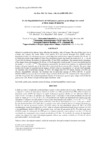Use este identificador para citar ou linkar para este item:
http://www.alice.cnptia.embrapa.br/alice/handle/doc/1013820Registro completo de metadados
| Campo DC | Valor | Idioma |
|---|---|---|
| dc.contributor.author | RIBEIRO JÚNIOR, G. de O. | pt_BR |
| dc.contributor.author | VELASCO, F. O. | pt_BR |
| dc.contributor.author | FARIA JÚNIOR, W. G. de | pt_BR |
| dc.contributor.author | TEIXEIRA, A. de M. | pt_BR |
| dc.contributor.author | MACHADO, F. S. | pt_BR |
| dc.contributor.author | MAGALHÃES, F. A. | pt_BR |
| dc.contributor.author | JAYME, D. G. | pt_BR |
| dc.contributor.author | GONÇALVES, L. C. | pt_BR |
| dc.date.accessioned | 2015-04-20T11:11:11Z | pt_BR |
| dc.date.available | 2015-04-20T11:11:11Z | pt_BR |
| dc.date.created | 2015-04-20 | pt_BR |
| dc.date.issued | 2014 | pt_BR |
| dc.identifier.citation | Arquivo Brasileiro de Medicina Veterinária e Zootecnia, v. 66, n. 6, p. 1883-1890, 2014. | pt_BR |
| dc.identifier.uri | http://www.alice.cnptia.embrapa.br/alice/handle/doc/1013820 | pt_BR |
| dc.description | ABSTRACT - Maturity is considered the primary factor affecting the nutritive value of forages. The aim of this study was to evaluate and compare dry matter (DM), crude protein (CP) and neutral detergent fiber (NDF) ruminal degradation kinetics of Andropogon gayanus grass silages harvested at three stages of maturity (56, 84 and 112 d). Dried and ground silage samples (5 mm) were incubated in nylon bags inside the rumen for 0, 6, 12, 24, 48, 72 and 96 h to estimate the kinetics of ruminal DM, CP and NDF degradation. The ruminal kinetic parameters of the silages from each treatment (56, 84 and 112 d of regrowth) in each animal (5 cows) were determined by the model: y = a + b(1 ? e?c(t?L)). The parameters generated by the model were analyzed as randomized block design, with grass regrowth age as the fixed effect and animal the as random effect (blocks). The grass silage ensiled with 56 days of regrowth had the highest (P<0.05) effective degradability of DM and NDF calculated for fractional rate of particulate passage of 2%/h. All silages had low CP soluble fraction (<25.4%) and effective degradability calculated for fractional rate of particulate passage of 2%/h (<40.1%). A greater (P<0.05) NDF lag time was observed for the silages ensiled with 84 and 112d compared to the silage produced with 56d of regrowth. The ruminal degradation kinetics of Andropogon gayanus grass silages showed that the grass ensiled with 56 days of regrowth had higher nutritional value. RESUMO - Maturity is considered the primary factor affecting the nutritive value of forages. The aim of this study was to evaluate and compare dry matter (DM), crude protein (CP) and neutral detergent fiber (NDF) ruminal degradation kinetics of Andropogon gayanus grass silages harvested at three stages of maturity (56, 84 and 112 d). Dried and ground silage samples (5 mm) were incubated in nylon bags inside the rumen for 0, 6, 12, 24, 48, 72 and 96 h to estimate the kinetics of ruminal DM, CP and NDF degradation. The ruminal kinetic parameters of the silages from each treatment (56, 84 and 112 d of regrowth) in each animal (5 cows) were determined by the model: y = a + b(1 ? e?c(t?L)). The parameters generated by the model were analyzed as randomized block design, with grass regrowth age as the fixed effect and animal the as random effect (blocks). The grass silage ensiled with 56 days of regrowth had the highest (P<0.05) effective degradability of DM and NDF calculated for fractional rate of particulate passage of 2%/h. All silages had low CP soluble fraction (<25.4%) and effective degradability calculated for fractional rate of particulate passage of 2%/h (<40.1%). A greater (P<0.05) NDF lag time was observed for the silages ensiled with 84 and 112d compared to the silage produced with 56d of regrowth. The ruminal degradation kinetics of Andropogon gayanus grass silages showed that the grass ensiled with 56 days of regrowth had higher nutritional value. | eng |
| dc.language.iso | eng | eng |
| dc.rights | openAccess | eng |
| dc.subject | Gamba grass | pt_BR |
| dc.subject | Maturity | pt_BR |
| dc.subject | Preserved forage | pt_BR |
| dc.subject | Ruminal degradability | pt_BR |
| dc.subject | Tropical grass | pt_BR |
| dc.title | In situ degradation kinetic of Andropogon gayanus grass silages harvested at three stages of maturity. | pt_BR |
| dc.type | Artigo de periódico | pt_BR |
| dc.date.updated | 2015-04-20T11:11:11Z | pt_BR |
| riaa.ainfo.id | 1013820 | pt_BR |
| riaa.ainfo.lastupdate | 2015-04-20 | pt_BR |
| dc.identifier.doi | https://doi.org/10.1590/1678-6780 | eng |
| dc.contributor.institution | G. DE O. RIBEIRO JÚNIOR, UFMG; F. O. VELASCO, UFMG; W. G. DE FARIA JÚNIOR, UFRR; A. DE M. TEIXEIRA, UFU; FERNANDA SAMARINI MACHADO, CNPGL; F. A. MAGALHÃES, UFMG; D. G. JAYME, UFMG; L. C. GONÇALVES, UFMG. | pt_BR |
| Aparece nas coleções: | Artigo em periódico indexado (CNPGL)  | |
Arquivos associados a este item:
| Arquivo | Descrição | Tamanho | Formato | |
|---|---|---|---|---|
| Cnpgl2014ArqBrasMedVetZInsitu.pdf | 184,94 kB | Adobe PDF |  Visualizar/Abrir |









